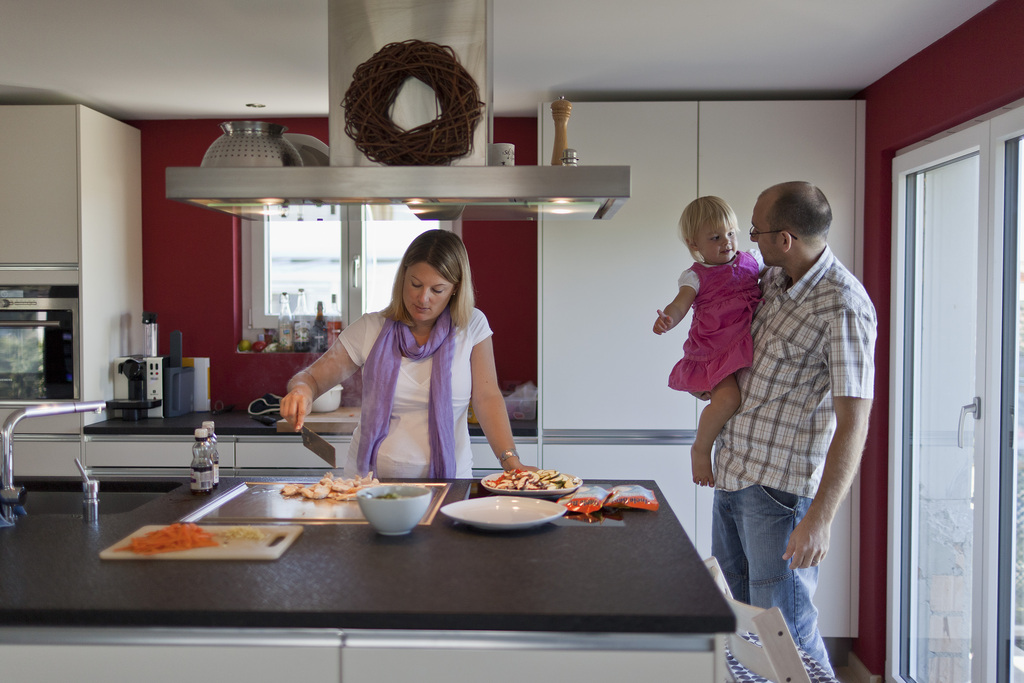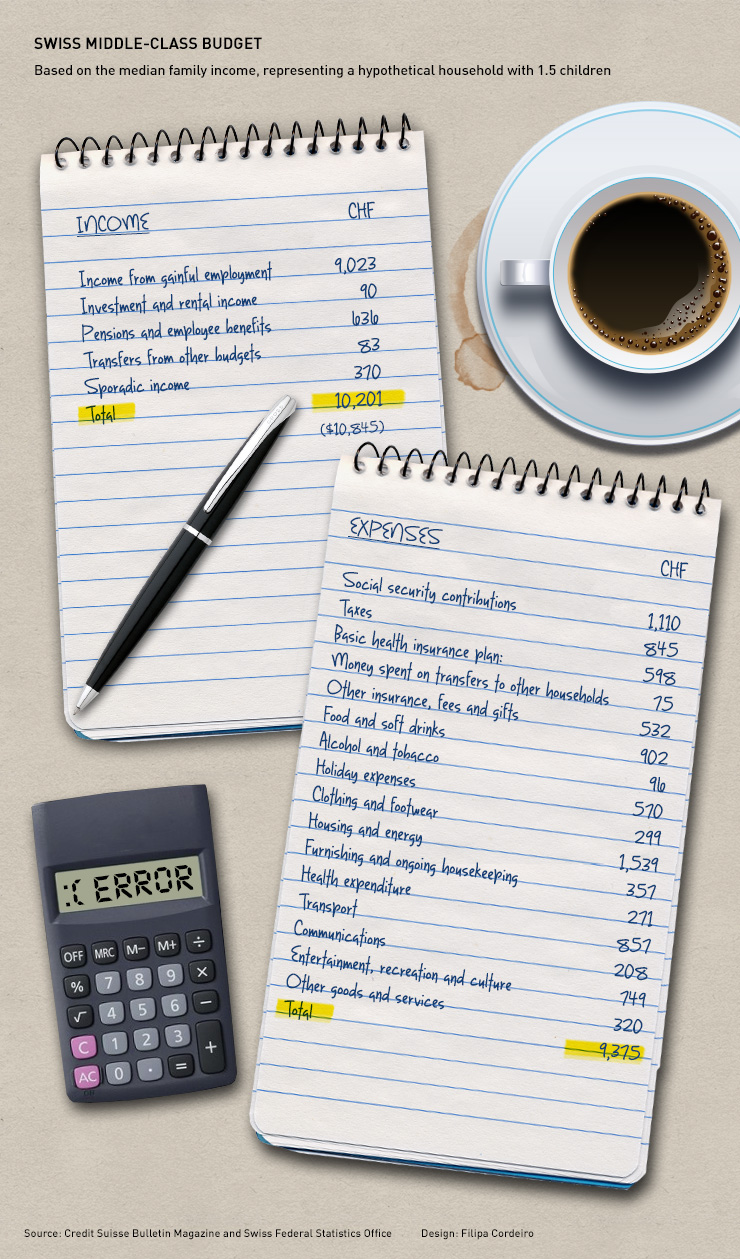Middle class boosted by working women

The middle class is under the microscope in Switzerland with recent studies analysing its well-being. Researchers agree many households are under financial pressure but the contribution of female earnings has boosted the bottom line.
In real terms, the middle class – defined variously as those earning 70 to 150 per cent of the average wage, or the middle-earning 60 per cent of the population – has a considerably higher income today than in 1990. However it has lost ground in comparison to higher and lower level earners.
Despite the fact that the Swiss middle class has remained sheltered from the global economic crisis and has not suffered a fall in income or the spectre of high unemployment, commentators point to a sense of insecurity and dissatisfaction – just the kind of climate that makes moves like the recent curb on EU immigration politically timely.
In its report The Strained Middle Class, liberal think tank Avenir Suisse highlights the fact that wages for middle-income groups increased at a slower rate than those of lower and higher earners between 1994 and 2010.
Switzerland was ranked seventh in the 2013 PwC Women in Work index in a sample of 27 OECD countries.
The shortfall of female wages relative to male wages (gender wage gap) is 19% in Switzerland, compared to 6% in Poland. Next best result was 7% for New Zealand and 8% in Norway. Countries with similar rates to Switzerland were Canada, Austria and Germany.
At 77% Switzerland’s rate of female labour force participation is close to that of the Nordic countries but the rate of working women in full-time employment is much lower in Switzerland (55%), compared to Norway (67%), Sweden (79%) and Finland (86%).
Source: PriceWaterhouseCoopers Women in Work index 2013
Catch-up
However because of a catch-up effect, women’s wages have grown faster, in some cases by more than twice as much as men’s. During the same period, women’s participation in the workforce increased significantly, reaching 77 per cent today, with just over half working full time.
“These two effects of faster growing wages and increasing participation have in combination led to what we call the feminisation of the middle class. This may not have really saved the middle class but it has helped a lot,” Patrick Schellenberger, co-author of the Avenir Suisse study told swissinfo.ch.
But this advantage is in danger of being undermined. According to Credit Suisse economist Sara Carnazzi Weber, a significant factor holding some women back from working more is the problem that a second income does not pay off for some families.
“You have cases of middle income households where the additional income from women working full time pushes the joint income into a higher tax bracket. Additional work-related expenses such as childcare can mean the family ends up financially worse off with two incomes,” Carnazzi Weber said.
“When a family with both parents working ends up with a smaller disposable income than that of a lower income household there is a disincentive to work which creates a significant loss from a wider economic point of view,” she added.

More
High expenses eat up middle class budget
Social standing
But there’s more at stake than money, Schellenberger explains. “What we’ve seen is that for many people in the middle class it has become very difficult to draw a boundary [to lower income groups]. Historians say it’s very important to the middle class to draw that boundary because it’s part of their self-image, the reward for what they do.”
So despite being highly skilled with good jobs and a good income, a level of resentment has crept in. Matthias Kuert of the union federation Travail Suisse finds this understandable.
“Middle income earners who are just about breaking even see their neighbours getting state support, for example health insurance subsidies, that they have to manage without. That bothers them,” Kuert said.
“What makes this more pronounced is that before when you made it to the middle class you would stay there. There was a sense of security. Now that security is gone,” he added. An illness, divorce or job loss can jeopardise everything.
The figure for average global wealth masks variation across countries and regions. This represents the mean value, i.e. the extrapolated total of all assets divided by the number of households.
Net worth or “wealth” is defined as the value of financial assets plus real assets (principally housing) owned by households, less their debts.
On this list the richest nations, with wealth per adult over $100,000, are found in North America, Western Europe, and among the rich Asia-Pacific and Middle Eastern countries.
Switzerland is out in front with $470,000 (2012), considerably higher than the level in Australia
($350,000) and Norway ($330,000), in second and third places despite falls of about 10% on 2011.
Japan is in fourth place with wealth of $270,000 per adult and the USA in seventh place with $260,000
per adult.
Close behind are a group of nations with average wealth above $200,000, such as France, Sweden,
Belgium, Denmark and Italy.
Source: Credit Suisse Global Wealth Report 2012
Making ends meet
Although the average values for the middle class appear robust, the figures conceal great diversity in circumstances. “In reality there are three different income groups within the middle class – lower, middle and upper,” Kuert said. “Taking an annual salary range of CHF60,000 to CHF200,000 is very broad.”
In a country where the 2012 Credit Suisse Global Wealth Report estimates average wealth per adult at CHF470,000, one quarter of all Swiss taxpayers have no assets aside from their pension fund balances.
So what bills are average earners in Switzerland faced with? The most recent Federal Statistics Office figures show that obligatory deductions, including taxes, social security and pension contributions, as well as health insurance premiums, take away 29 per cent of the average household income.
Housing and energy make up the largest single expense, accounting for one fifth of disposal income. (For a detailed breakdown of income and outgoings, see infographic.)
But there is sharp contrast here between established residents who have owned or rented their property for some time and newcomers to the market who have been affected by the dramatic increase in real estate prices and rents in urban areas.
According to Schellenberger’s co-author Daniel Müller Jentsch, more people are burdened by property prices in boom regions such as Geneva and Zurich. “In some parts of the Swiss economy, especially in the low-wage cantons, the cost of living has increased faster so the purchasing power has been eroded,” he told swissinfo.ch.
However, in terms of international comparison the middle class in Switzerland has been squeezed much less than in other industrialised economies in Europe and elsewhere, Müller Jentsch added.

In compliance with the JTI standards
More: SWI swissinfo.ch certified by the Journalism Trust Initiative

You can find an overview of ongoing debates with our journalists here. Please join us!
If you want to start a conversation about a topic raised in this article or want to report factual errors, email us at english@swissinfo.ch.